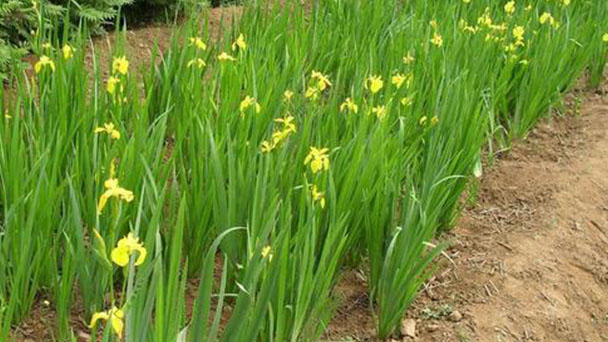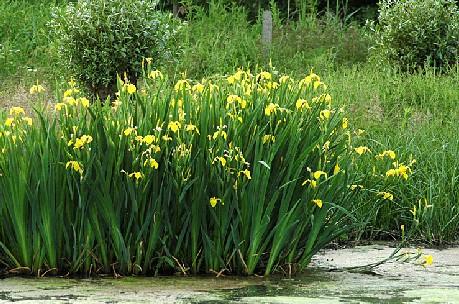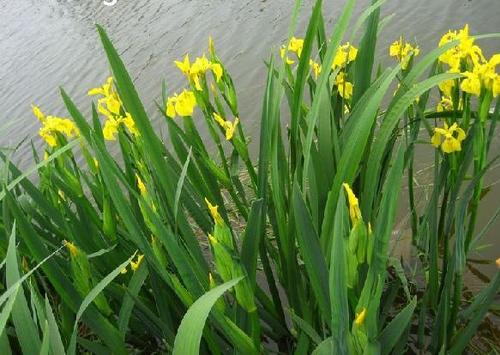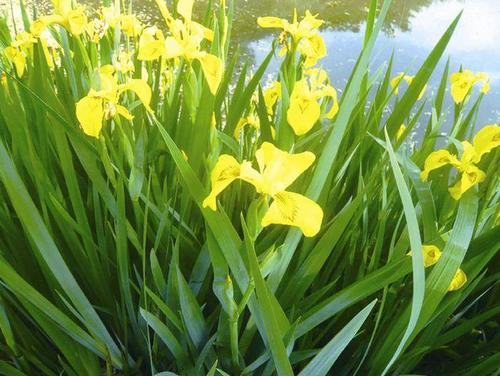Yellow iris profile
Written by Maggie
Dec 21 2020

Iris pseudacorus, the yellow flag, yellow iris, or water flag, is a species of flowering plant in the family Iridaceae. It is native to Europe, western Asia and northwest Africa.
Yellow Iris is native to Europe and is commonly grown throughout China. It is found in wetlands or marshes along rivers and lakes.
Yellow Iris has a wide range of adaptability. It can be cultivated near water or in open fields, or in water. It is a rare flower that can grow both aquatic and terrestrial. Yellow Iris is also a good medicine. Dry roots can relieve toothache, regulate menstruation, treat diarrhea, and can also be used as dyes.
Yellow Iris picture

Yellow Iris morphological characteristics
Yellow iris is a perennial herb with a small amount of residual fibers from the old leaves around the base of the plant.Rhizomes stout, up to 2.5 cm in diameter, obliquely extended, nodes conspicuous, yellow-brown; The fibrous root is yellow and white, have contracted horizontal grain. Leaves are grayish green, broadly sword-shaped, 40-60 cm long and 1.5-3 cm wide, apically acuminate, basally sheathed, pale, midvein distinct.
Stems are stout, 60-70 cm high, 4-6 mm in diam., longitudinally ribbed, upper branched, cauline leaves shorter and narrower than basal ones; Yellow Iris has 3-4 bracts, membranous, green, lanceolate, 6.5 -- 8.5 cm long, 1.5 -- 2 cm wide, apically acuminate; Flowers are yellow, 10-11 cm in diameter;Pedicels 5-5.5 cm long; The perianth is 1.5 cm long, outer perianth segments obovate or obovate, ca.7 cm long and 4.5 -- 5 cm wide, jaws narrowly cuneate, central depression furrowed, with dark brown stripes, inner perianth segments smaller, oblanceolate, erect, 2.7 cm long, ca.5 mm wide; Stamens ca. is 3 cm, filaments yellowish white, anthers blackish purple; Yellow Iris style branches are pale yellow, ca. 4.5 cm long, ca.2.2 cm wide, apex lobes semicircular, margin sparsely dentate, ovary green, trigonal columnar, ca. 2.5 cm long, ca.5 mm in diam. Flowering period is in May, fruit period June - August.
Habitats of Yellow Iris
Yellow Iris is native to Europe and is commonly grown throughout China. It is found in wetlands or marshes along rivers and lakes.Yellow Iris likes warm water wet environments, like fertile soil, strong cold resistance.

Yellow Iris propagation method
Division
Plant propagation is mainly used in small scale production and garden greening, especially in garden greening, which is more economical and applicable. The perennial Yellow iris has grown into large clumps, which are divided into several plants that bloom the same year. The plants can be divided in spring and autumn. In Heilongjiang Province of China, plant propagation was usually carried out before May Day in spring. If it is autumn, it is better to do it in early August.
Dig out the mother plant of Yellow Iris before planting, shake off the soil, cut off the leaf cluster at 2-3 cm above the buried line, break open or cut with a sharp knife, each plant with 2-3 buds, then sprinkle the wound with wood ash or sulfur powder. After dry in the dark, you can plant.6 cm ×6 cm row spacing can be used for planting in a nursery. If it is used in landscape engineering, 10 cm ×15 cm line spacing can be used; A 10 cm ×20 cm row spacing may be used for seed collection purposes. The depth of planting is related to the soil quality. If planted in clay soil, the buried soil should be 1-2 cm lower than the cutting mouth of stem and leaf. If planted in sandy soil, it should be 1-2 cm deeper than in clay. When planted, the stems and leaves should be exposed slightly rather than completely buried to facilitate growth and flowering. For the purpose of producing seedlings, 600-750kg compound fertilizer and 150-300kg urea should be applied on a hectare; For the purpose of seed collection, compound fertilizer of 750-900 kg, diammonium phosphate 300-450 kg and potassium chloride 75-150 kg should be applied to the hectare.
Sow
Nursery preparation: Choose leeward to the sun, flat terrain, fertile soil, rich in organic matter, and drainage and irrigation facilities, convenient transportation as a seedbed. According to the seedbed and field ratio of 1:10 (-20) to implement the seedbed area. Apply 10-22.5 tons of farm manure and 100-150 kilograms of diammonium phosphate as base fertilizer to the hectare, rotate the ridge, the ridge distance is 70 cm.
Sowing method: Autumn sowing is adopted in Heilongjiang province, China. In August, the seeds are ripe. After collecting the seeds, they can be sown, and the seedling rate is high. There are many ways to sow.1. Drill on ridges: Use tractors to pull heavy wood squares in the field. First, the ridge top can be removed, and make 15-20 cm wide furrows on the ridge top. After sowing, keep the soil moist. Burrow sowing on ridges: after burrowing and suppressing, dig pits 25 cm apart, the pits are 7-10 cm deep, sow yellow calamus seeds about 20 seeds in each pit, bury the soil 3 cm, and slightly compacted.

Yellow Iris main value
Ornamental: Yellow Iris has a wide range of adaptability. It can be cultivated near water or in open fields, or in water. Yellow Iris is a rare flower that can grow both aquatic and terrestrial. Yellow calamus planted in pieces in the shallow water of parks, scenic areas and premises can soften the hard landscape, achieve the harmony between buildings, stones and nature, and achieve the landscape effect of being graceful and full of vitality.
Medicine and economy: Yellow Iris is also good medicine. Dry roots can relieve toothache, regulate menstruation, treat diarrhea, and can also be used as dyes.
Latest Updated
- Benefits of Bugleweed - 7 Science-backed Health Benefits
- Bugleweed Dangers & Side Effects - Is It Poisonous?
- How to Plant Evergreen Trees - What You Should Know
- When to Plant Evergreens - Grow Guide for Evergreen Trees
- 12 Wonderful Evergreen Shrubs for Your Garden
- 12 Popular Evergreen Plants with Pictures for Beginners
- When And How To Prune A Lilac Bush Like a Pro
- How to Grow & Care for Lilac Vine (Hardenbergia Violacea)
- Japanese Lilac Tree (Syringa Reticulata) Care & Propagation Guide
- Shumard Oak Pros and Cons - What to Know
Popular Articles
- Winter maintenance of Antirrhinum Majus
- How to Grow Terminalia Mantaly Tree
- How to Grow and Care for Crossostephium Chinense
- How to grow Antirrhinum Majus in spring
- Peristeria Elata (Dove Orchid) Profile: Info & Care Guide
- Underwatered Snake Plant (Sansevieria Trifasciata) - Signs And How To Fix
- How to Care for Brazilian Jasmine Plant (Mandevilla Sanderi)
- How to Grow & Care for Graptopetalum Purple Delight in Summer
- Rosa Chinensis (China Rose): Plant Growing & Care Tips
- How to Care for Baby Sun Rose (Aptenia Cordifolia)